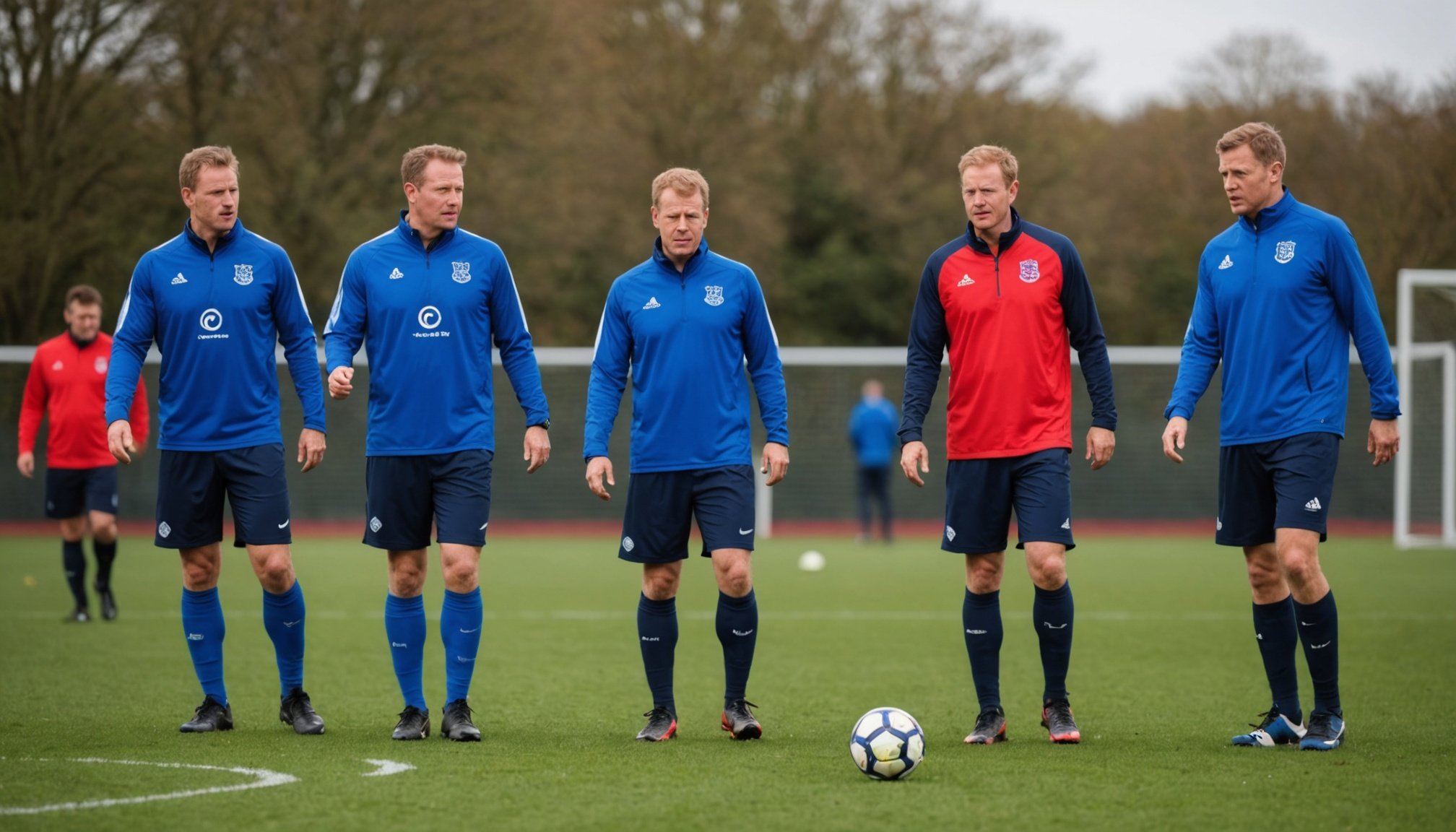Understanding the Impact of Prolonged Injuries
Prolonged injuries can significantly affect a player’s psychology and performance. The frustration of being away from the game, coupled with physical limitations, can lead to mental health challenges, like anxiety or depression. Mental health support is crucial during this period. Providing players with resources such as counseling can help them navigate these emotional hurdles and maintain motivation.
Assessing a player’s readiness to return involves several strategies. Physical and mental health need thorough evaluation before a player steps back onto the field. It’s essential to understand that rushing the process can lead to re-injury or worsen the player’s mental state. Regular consultations with medical professionals and mental health experts ensure that players are genuinely ready for action.
In parallel : Harnessing Tactical Brilliance: How Virtual Reality Transforms Football Coaching
Maintaining player empowerment during recovery is also essential. Empowered players often exhibit better resilience and adherence to rehabilitation programs. Encouraging them to set personal goals, participate actively in their recovery plan, and stay connected with teammates can foster a sense of control over their situation. This approach contributes to quicker and more effective rehabilitation outcomes, ultimately enhancing their long-term performance.
Innovative Training Techniques for Rehabilitation
Incorporating technology into rehabilitation strategies can revolutionize recovery effectiveness. Wearables have transformed physical conditioning by enabling precise monitoring of recovery and physical performance. These devices track vital metrics that help tailor training to an individual’s specific injury, ensuring optimal pace in their recovery journey.
In the same genre : Reigniting Team Morale: Proven Tactics for Football Coaches to Motivate Players After a Defeat
Incorporating Technology in Training
Virtual reality simulations are another innovation in training innovations. They offer immersive environments to practice real-time scenarios, improve motor skills, and enhance mental preparedness, making them particularly valuable for athletes recovering from injury. These technologies provide essential feedback, allowing adjustments to rehabilitation strategies based on comprehensive data.
Functional Movement and Conditioning Programs
Functional movement plays a critical role in rehabilitation by promoting muscle memory and joint stability. Tailored conditioning programs that target specific injuries are crucial for successful recovery. These programs focus on movements that mimic daily activities, helping players regain their strength and agility effectively.
Collaboration with Physiotherapy
Integrating physiotherapists into training ensures a holistic approach to injury recovery. Collaboration fosters a team environment where coaches, physiotherapists, and players work together. This cooperation enhances rehabilitation outcomes by aligning training innovations with necessary physical interventions, ultimately ensuring a smoother recovery path for the player.
Psychological Approaches to Empower Players
Navigating injury recovery requires not only physical rehabilitation but also robust psychological support. Cultivating mental resilience is essential in maintaining a player’s optimism and strength during challenging times. Developing resilience can be achieved through mindfulness practices, cognitive behavioural therapy, and fostering a growth mindset, which empowers players to view setbacks as opportunities for development.
Setting achievable goals offers players measurable benchmarks, boosting motivation throughout their recovery process. These goals must be realistic and tailored to the individual’s current capabilities, ensuring players stay focused and mentally engaged in their rehabilitation journey. Celebrating small victories keeps spirits high and mindsets positive.
Creating a supportive environment is crucial for safeguarding players’ mental health. This environment can be cultivated through open communication with peers, coaches, and mental health professionals. Establishing trust and empathy in these relationships provides a safety net, offering players a refuge from mental strain.
Encouraging participation in team activities, even during recovery, maintains connection and camaraderie within the team. This ongoing involvement not only remedies feelings of isolation but reinforces a player’s role within the team dynamic, highlighting the importance of both mental and physical well-being in a successful recovery.
Fostering Team Dynamics and Communication
Team Cohesion and open communication are essential ingredients for successful recovery and overall team harmony. Encouraging team involvement in the recovery process can significantly enhance a player’s morale. Activities like group rehabilitation sessions or inclusion in strategy meetings keep injured players engaged and promote a sense of belonging. Teammates play a pivotal role in motivating recovery efforts, acting as a support system to uplift spirits and encourage adherence to rehabilitation programs.
Encouraging Team Involvement in Recovery
Participation in team activities allows injured players to maintain a connection with the squad, reducing feelings of isolation. This involvement is crucial for sustained motivation and can be facilitated by roles that accommodate their physical limitations.
Establishing Open Communication Channels
Open communication between players and coaches fosters a supportive environment. Tools for feedback include regular check-ins and discussions that provide players with opportunities to voice concerns and celebrate progress. Such communication ensures alignment in goals and expectations, creating a positive feedback loop.
Building Trust and Empathy within the Team
Trust and empathy are cultivated through training sessions focused on collaborative exercises. Sharing recovery stories can offer inspiration and foster camaraderie, strengthening bonds amongst teammates and providing emotional reassurance.
Case Studies and Success Stories
Exploring real-life case studies provides valuable insights into successful injury recovery programs across UK football clubs. These examples demonstrate the diversity of tactics employed to bring players back to peak performance, offering inspiration and practical ideas for developing tailored recovery plans.
One notable success story involved a well-known UK team, which successfully rehabilitated a key player using an integrated approach. Incorporating advanced training innovations and mental health support, the player returned to play stronger than before. This case highlighted the importance of a holistic strategy, integrating conditioning programs with mental resilience exercises.
A different case study revealed innovative methods through wearable technology and virtual reality simulations. Utilizing these tools allowed the players to engage in simulated game scenarios, assisting them in maintaining mental sharpness during their physical absence from the field. This technique offered essential feedback, enabling precision adjustments in training intensity and focus.
Lessons gathered from challenges in these cases include the significance of continuous communication between players and medical teams. Strategies must be adaptable, meeting individual-specific recovery needs while prioritizing mental well-being. The value of real-life examples lies in their ability to motivate coaches and players alike to adopt comprehensive and effective rehabilitation strategies.
Practical Action Plan for Coaches
Creating a step-by-step guide is essential for coaches aiming to facilitate effective player recovery. Establishing assessment tools is the first step. These tools provide a framework for evaluating a player’s readiness, both physically and psychologically. Metrics such as agility tests and mental resilience evaluations offer insights into their preparedness to rejoin competitive play.
Assessment Tools for Coaches
To ensure accuracy, coaches should employ objective measures. Examples include GPS trackers for tracking movement and reaction time drills to gauge cognitive sharpness. Regularly updating these assessments ensures both physical and psychological progress are adequately monitored, paving the way for a safe return.
Developing Individualized Recovery Plans
Coaching strategies must be flexible and personalized. Each player’s plan should reflect the specific nature of their injury and their unique recovery needs. Flexibility in training schedules allows for adjustments based on progress, while consistent communication strategies with each player help tailor their recovery plan.
Monitoring and Adjusting Plans
To promote steady progression, plans should be continually evaluated. Implementation plans that incorporate feedback loops enable coaches to make necessary adjustments. This adaptive approach not only ensures optimal recovery but also instills confidence in players, knowing their development is tracked with precision and care.




